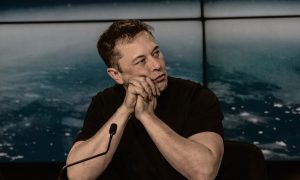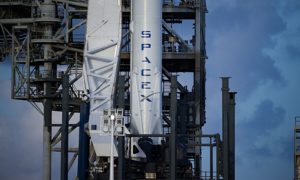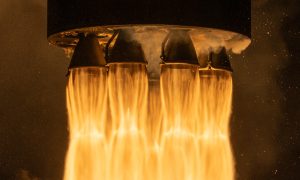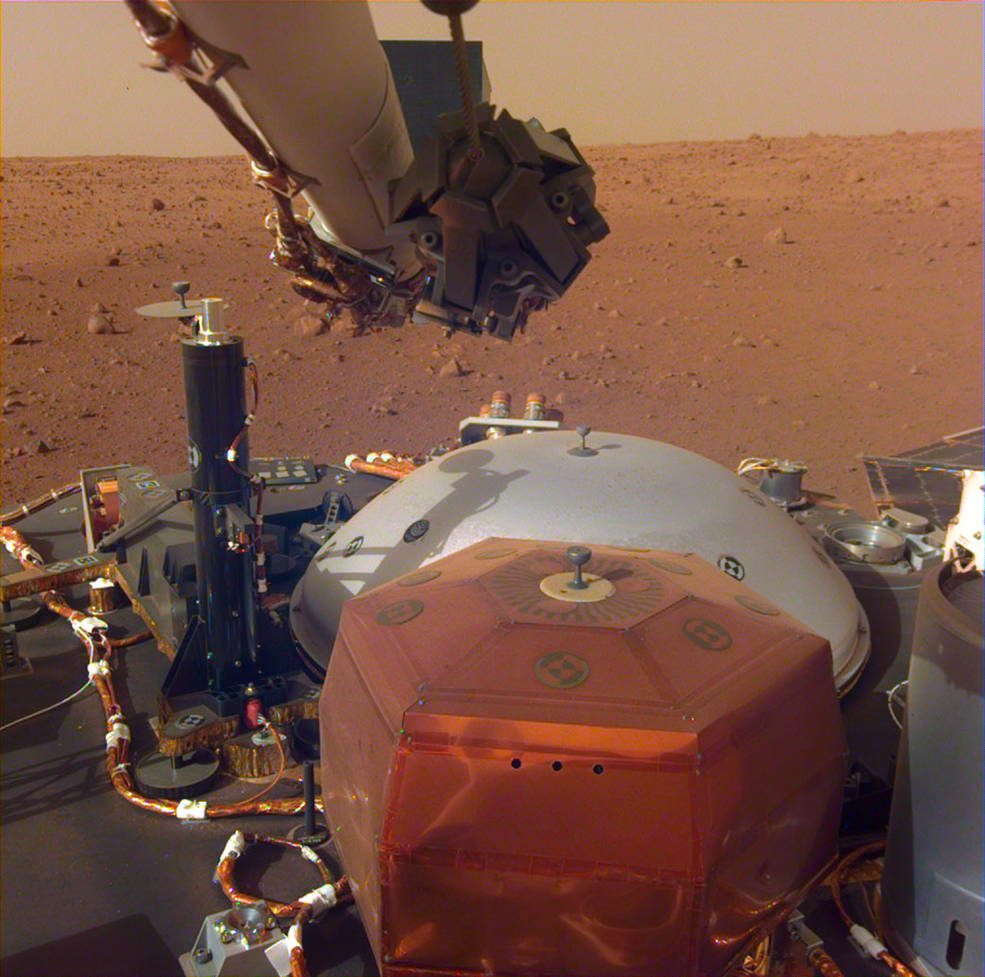

News
First sounds of wind on Mars captured by NASA’s Insight Lander
This fresh in from the Elysium Planitia of Mars: the sound of wind from an alien world. On its 10th day as a new resident of the red planet, NASA’s InSight lander’s pressure sensor transmitted air vibration data from its trembling solar panels, representing a steady breeze about 99 million miles away. The combination of photos sent back from the craft with the sound of Martian wind gives Earth residents a unique moment to feel like they’ve joined the craft themselves. “It’s fun to imagine that I’m there,” mused Don Banfield during a JPL media teleconference discussing the recording. Banfield is InSight’s Auxiliary Payload Sensor Subsystem (APSS) Science Lead.
InSight, short for “Interior Exploration using Seismic Investigations, Geodesy and Heat Transport”, launched aboard an Atlas V rocket on May 5, 2018 and successfully landed on the Martian surface on November 26, 2018. The craft is a seismic investigator sent to study the red planet’s core, eventually drilling 10-16 feet down into its crust to gather geographical data. The craft’s landing event was live streamed online for viewers around the world, greeting Earthlings with a photo of its new home’s surface shortly after. It sent back more photos of the surrounding area prior to the wind recording.
The thin CO2 atmosphere on Mars doesn’t translate high sounds well, so the recorded vibrations from InSight’s pressure sensor are low on the audio spectrum, under 50 Hz, thus difficult to hear. However, after the frequency was increased by a factor of 100 (raised two octaves), it became possible to hear what sounds like a steady wind blowing across the regolith. Dust devils tracked in the area moving across the Martian surface had motion consistent with the wind recordings, thus confirming what was being heard by InSight’s scientists.

The way InSight picks up and translates sound is similar to how a human ear works: Air pressure vibrates the eardrum, then that vibration pattern is sent through the inner ear bones to the cochlea which has tiny hairs translating the vibrations into electrical signals sent to the brain. InSight’s solar panels are like its eardrums, the spacecraft structure itself like its inner ear, its instruments like its cochlear, and its electronic box translating and transmitting signals is like brain. The “sounds” we hear from Mars are translated data from wind-caused vibrations.
Ironically enough, wind noise is actually not a particularly desired outcome from InSight’s instruments. According to the scientists participating in NASA’s teleconference discussing the event, the inlet for the pressure sensor was specifically designed to minimize any chatter from air movement. Also, the placement of InSight’s seismographic gear will be based on the best area to reduce input from the lander’s interaction with the vibrations it’s recording, i.e., the lander’s movement from seismic events. It should be noted, though, the Martian wind gracing our human ears for the first time is only a taste of what’s to come from InSight’s instruments.
Once the wind and thermal shield (the white dome in the photos) has been lifted from the lander in a few weeks, all of InSight’s instruments will be exposed to the Martian environment for data collection. For now, the lander’s Earth-based team is first focusing on understanding the area the craft is in to pick the best place to set its instruments. After the main mission begins, however, a full study of Mars’ atmosphere will be underway and we could hear, among other natural events, the sounds of exploding meteors.
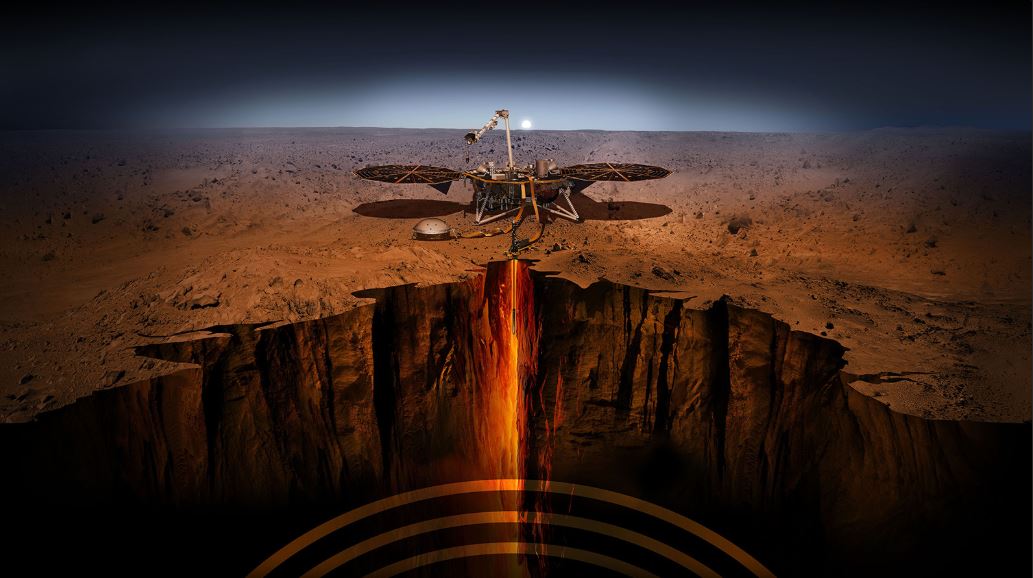
While wind may be a unique sound to hear on an alien world, it’s not the first time a NASA craft has entertained our ears and imaginations. Electromagnetic vibrations have been recorded all across our solar system, perhaps the most famous of which originated from the Voyager 1 spacecraft launched in 1977. The data collected from the craft’s radio-capturing instruments has been converted into audio files – you can even find a full album’s worth of the sounds on a variety of streaming sites. Some of the recordings are meditation-worthy, others a touch unnerving. We humans have additionally added some recordings of our own to space via Voyager’s famous “golden record”, the sounds of which are also available for listening online.
If you’re craving a full Martian soundtrack, you’ll be happy to know that NASA’s Mars 2020 rover is planned to provide just that. It will have two microphones on board, one of which will record the actual landing of the rover. Combined with telemetry data and surface photographs, Mars is on its way to its own documentary with inputs completely provided “on-location”. Stay tuned!
Listen to the Martian wind yourself below:
Elon Musk
Tesla Supercharger Diner food menu gets a sneak peek as construction closes out
What are you ordering at the Tesla Diner?

The Tesla Supercharger Diner in Los Angeles is nearing completion as construction appears to be winding down significantly. However, the more minor details, such as what the company will serve at its 50s-style diner for food, are starting to be revealed.
Tesla’s Supercharger Diner is set to open soon, seven years after CEO Elon Musk first drafted the idea in a post on X in 2018. Musk has largely come through on most of what he envisioned for the project: the diner, the massive movie screens, and the intended vibe are all present, thanks to the aerial and ground footage shared on social media.
We already know the Diner will be open 24/7, based on decals placed on the front door of the restaurant that were shared earlier this week. We assume that Tesla Optimus will come into play for these long and uninterrupted hours.
The Tesla Diner is basically finished—here’s what it looks like
As far as the food, Tesla does have an email also printed on the front door of the Diner, but we did not receive any response back (yet) about what cuisine it will be offering. We figured it would be nothing fancy and it would be typical diner staples: burgers, fries, wings, milkshakes, etc.
According to pictures taken by @Tesla_lighting_, which were shared by Not a Tesla App, the food will be just that: quick and affordable meals that diners do well. It’s nothing crazy, just typical staples you’d find at any diner, just with a Tesla twist:
Tesla Diner food:
• Burgers
• Fries
• Chicken Wings
• Hot Dogs
• Hand-spun milkshakes
• And more https://t.co/kzFf20YZQq pic.twitter.com/aRv02TzouY— Sawyer Merritt (@SawyerMerritt) July 17, 2025
As the food menu is finalized, we will be sure to share any details Tesla provides, including a full list of what will be served and its prices.
Additionally, the entire property appears to be nearing its final construction stages, and it seems it may even be nearing completion. The movie screens are already up and showing videos of things like SpaceX launches.
There are many cars already using the Superchargers at the restaurant, and employees inside the facility look to be putting the finishing touches on the interior.
🚨 Boots on the ground at the Tesla Diner:
— TESLARATI (@Teslarati) July 17, 2025
It’s almost reminiscent of a Tesla version of a Buc-ee’s, a southern staple convenience store that offers much more than a traditional gas station. Of course, Tesla’s version is futuristic and more catered to the company’s image, but the idea is the same.
It’s a one-stop shop for anything you’d need to recharge as a Tesla owner. Los Angeles building permits have not yet revealed the date for the restaurant’s initial operation, but Tesla may have its eye on a target date that will likely be announced during next week’s Earnings Call.
News
Tesla’s longer Model Y did not scale back requests for this vehicle type from fans
Tesla fans are happy with the new Model Y, but they’re still vocal about the need for something else.

Tesla launched a slightly longer version of the Model Y all-electric crossover in China, and with it being extremely likely that the vehicle will make its way to other markets, including the United States, fans are still looking for something more.
The new Model Y L in China boasts a slightly larger wheelbase than its original version, giving slightly more interior room with a sixth seat, thanks to a third row.
Tesla exec hints at useful and potentially killer Model Y L feature
Tesla has said throughout the past year that it would focus on developing its affordable, compact models, which were set to begin production in the first half of the year. The company has not indicated whether it met that timeline or not, but many are hoping to see unveilings of those designs potentially during the Q3 earnings call.
However, the modifications to the Model Y, which have not yet been officially announced for any markets outside of China, still don’t seem to be what owners and fans are looking forward to. Instead, they are hoping for something larger.
A few months ago, I reported on the overall consensus within the Tesla community that the company needs a full-size SUV, minivan, or even a cargo van that would be ideal for camping or business use.
Tesla is missing one type of vehicle in its lineup and fans want it fast
That mentality still seems very present amongst fans and owners, who state that a full-size SUV with enough seating for a larger family, more capability in terms of cargo space for camping or business operation, and something to compete with gas cars like the Chevrolet Tahoe, Ford Expedition, or electric ones like the Volkswagen ID.BUZZ.
We asked the question on X, and Tesla fans were nearly unanimously in support of a larger SUV or minivan-type vehicle for the company’s lineup:
🚨 More and more people are *still* saying that, despite this new, longer Model Y, Tesla still needs a true three-row SUV
Do you agree? https://t.co/QmbRDcCE08 pic.twitter.com/p6m5zB4sDZ
— TESLARATI (@Teslarati) July 16, 2025
Here’s what some of the respondents said:
100% agree, we need a larger vehicle.
Our model Y is quickly getting too small for our family of 5 as the kids grow. A slightly longer Y with an extra seat is nice but it’s not enough if you’re looking to take it on road trips/vacations/ kids sports gear etc.
Unfortunately we…
— Anthony Hunter (@_LiarsDice_) July 17, 2025
Had to buy a Kia Carnival Hybrid because Tesla doesn’t have a true 3 row vehicle with proper space and respectable range. pic.twitter.com/pzwFyHU8Gi
— Neil, like the astronaut (@Neileeyo) July 17, 2025
Agreed! I’m not sure who created this but I liked it enough to save it. pic.twitter.com/Sof5nMehjS
— 🦉Wise Words of Wisdom – Inspirational Quotes (IQ) (@WiseWordsIQ) July 16, 2025
Tesla is certainly aware that many of its owners would like the company to develop something larger that competes with the large SUVs on the market.
However, it has not stated that anything like that is in the current plans for future vehicles, as it has made a concerted effort to develop Robotaxi alongside the affordable, compact models that it claims are in development.
It has already unveiled the Robovan, a people-mover that can seat up to 20 passengers in a lounge-like interior.
The Robovan will be completely driverless, so it’s unlikely we will see it before the release of a fully autonomous Full Self-Driving suite from Tesla.
Energy
Tesla launches first Virtual Power Plant in UK – get paid to use solar
Tesla has launched its first-ever Virtual Power Plant program in the United Kingdom.

Tesla has launched its first-ever Virtual Power Plant program in the United Kingdom. This feature enables users of solar panels and energy storage systems to sell their excess energy back to the grid.
Tesla is utilizing Octopus Energy, a British renewable energy company that operates in multiple markets, including the UK, France, Germany, Italy, Spain, Australia, Japan, New Zealand, and the United States, as the provider for the VPP launch in the region.
The company states that those who enroll in the program can earn up to £300 per month.
Tesla has operated several VPP programs worldwide, most notably in California, Texas, Connecticut, and the U.S. territory of Puerto Rico. This is not the first time Tesla has operated a VPP outside the United States, as there are programs in Australia, Japan, and New Zealand.
This is its first in the UK:
Our first VPP in the UK
You can get paid to share your energy – store excess energy in your Powerwall & sell it back to the grid
You’re making £££ and the community is powered by clean energy
Win-win pic.twitter.com/evhMtJpgy1
— Tesla UK (@tesla_uk) July 17, 2025
Tesla is not the only company that is working with Octopus Energy in the UK for the VPP, as it joins SolarEdge, GivEnergy, and Enphase as other companies that utilize the Octopus platform for their project operations.
It has been six years since Tesla launched its first VPP, as it started its first in Australia back in 2019. In 2024, Tesla paid out over $10 million to those participating in the program.
Participating in the VPP program that Tesla offers not only provides enrolled individuals with the opportunity to earn money, but it also contributes to grid stabilization by supporting local energy grids.
-

 Elon Musk1 day ago
Elon Musk1 day agoWaymo responds to Tesla’s Robotaxi expansion in Austin with bold statement
-

 News1 day ago
News1 day agoTesla exec hints at useful and potentially killer Model Y L feature
-

 Elon Musk2 days ago
Elon Musk2 days agoElon Musk reveals SpaceX’s target for Starship’s 10th launch
-

 Elon Musk3 days ago
Elon Musk3 days agoTesla ups Robotaxi fare price to another comical figure with service area expansion
-

 News1 day ago
News1 day agoTesla’s longer Model Y did not scale back requests for this vehicle type from fans
-

 News1 day ago
News1 day ago“Worthy of respect:” Six-seat Model Y L acknowledged by Tesla China’s biggest rivals
-

 News2 days ago
News2 days agoFirst glimpse of Tesla Model Y with six seats and extended wheelbase
-

 Elon Musk2 days ago
Elon Musk2 days agoElon Musk confirms Tesla is already rolling out a new feature for in-car Grok


